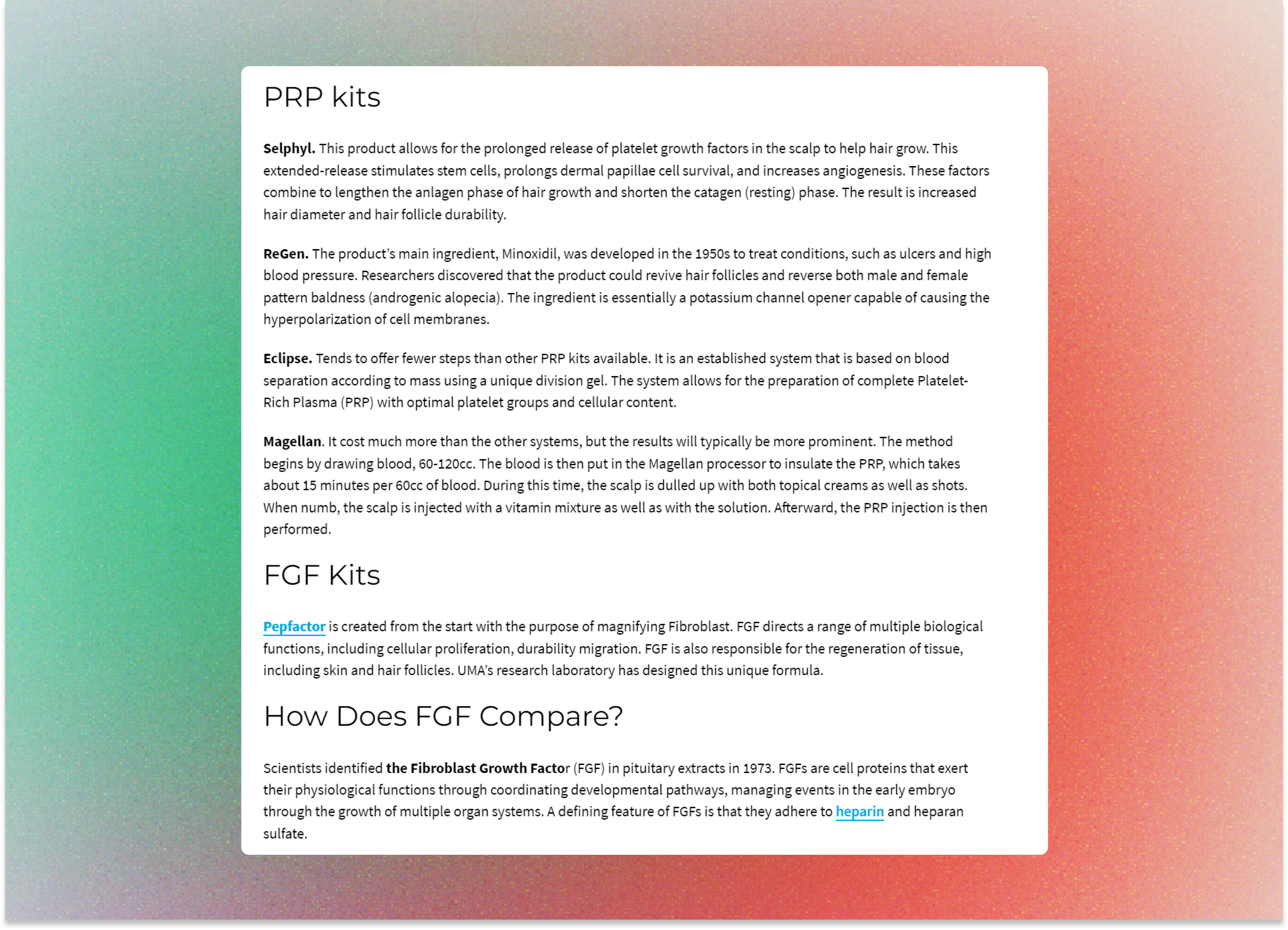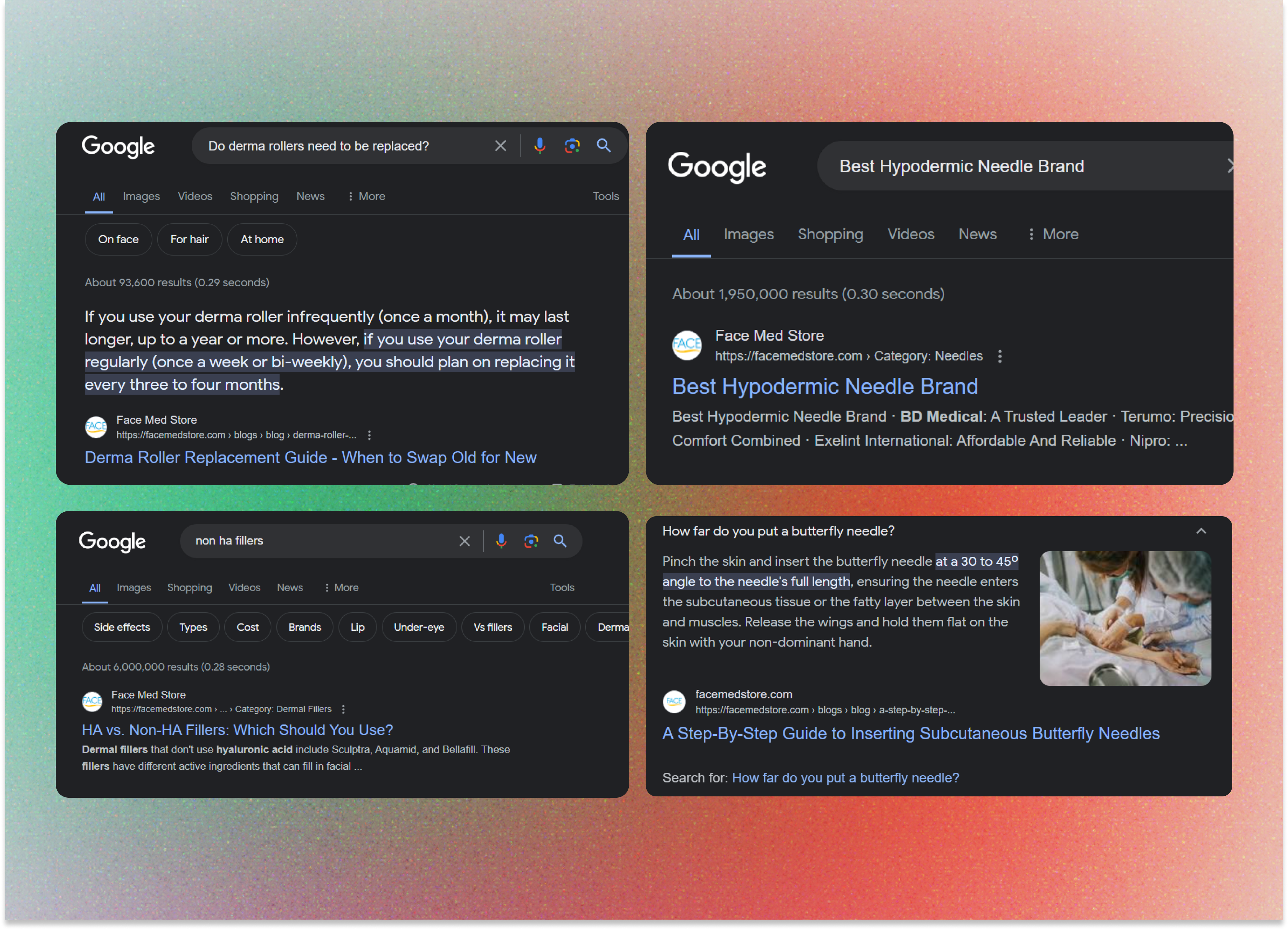Project Overview
FaceMedStore is an e-Commerce brand in the $60-100k MRR range selling aesthetic medical supplies to dermatologists and aestheticians. The store also sells online training courses for cosmetic dermatology.
FaceMedStore is a project I worked on during my time as founder at Writrly. “We” refers to the writing team I trained and scaled during this engagement. See tasks performed for my individual contributions.
Content Goals
- Develop high-quality technical SEO articles on injectables, exosomes, PRP technology, and other modern aesthetic medicine procedures and products
- Build trust within the cosmetic dermatology community by publishing medically accurate resources
- Win SERPS and rank highly on competitive keywords by understanding the user’s search intent
Output and Deliverables

FaceMedStore was working with growth agency Authoritly in creating a huge content library of 50+ content pieces.
I worked directly with an SEO strategist in building FaceMedStore’s content library, starting at a pace of 8 articles/month and growing up to 16 articles/month after seeing considerable results in their SEO strategy.
We followed a pillar-cluster article structure for a wide variety of highly technical topics, including:
Dermal fillers:
- Is Doxycycline Effective for Managing Nodules From Dermal Fillers?
- Why Dermatologists Should Study The Rheology Of Their Dermal Fillers
- Delayed Onset Nodules From Dermal Fillers: Diagnosis and Treatment
- Can a CT Scan Detect the Difference between Dermal Filler from Nodules?
Fibroblast Growth Factor
- Using Fibroblast Growth Factor To Rejuvenate Your Hair And Skin
- Role Of Fibroblast Growth Factors In Tissue Healing
- Fibroblast Growth Factors Stimulates Hair Growth
Exosome
- How Stem Cell Therapy And Exosomes Compare
- Is Exosome Therapy FDA Approved?
- Exosomes As A Novel Therapy For Treatment And Prevention Of Diseases
The content strategy also included articles on aesthetic medicine as a career, as part of the campaign to sell their online training courses:
- A Guide to Med Spa Regulations by State
- How to Renew an Esthetician License
- A Guide On How To Become A Nurse Esthetician
- How to Get Dual Licensed As An Esthetician
We also developed content for landing pages, product pages, and other content-based touchpoints for the site:
Product pages
See all here
Content tone
These resources are:
Zero fluff, only value
We were sensitive to the search intent and asked ourselves "what does the user already know about this topic, and why are they asking about this instead?"
We created pieces that were straight-to-the-point, had great UX, and respected the reader's time and understanding of the topic.

Authoritative
High-authority articles = great community reputation.
Authority isn't just about embracing jargon and "speaking their language". We brought authority by providing clear solutions or answers to queries whenever possible and linking them back to resources.
When queries came back with non-conclusive answers, we clearly stated why they were non-conclusive. This builds trust within the community because it shows the brand is nuanced and reflects the reality of medical journals.

Expert-level
We used living style guides to create an internal knowledge base on medical facts based on previous corrections and edits from the subject matter expert.
This ensured that all articles produced were in line with corrections, nuances, and preferences from the subject matter expert - despite the writing team having no formal medical or dermatology background.

Tasks Performed
- Collaborated with the SEO strategist in understanding the search intent behind the titles
- Led feedback initiatives with the subject matter expert to develop a living style guide
- Developed the first round of content to gather feedback and set a baseline for future writers
- Scaled content production by personally vetting, training, and providing feedback to writers with little to no medical backgrounds
- Ensured that the articles are SEO-compliant by implementing the use of tools like Frase and Market Muse
Challenges
How do we write expert-level articles in an industry, as non-natives in the field?
How do we pass off as “natives” to an industry?
Sounding “native” isn’t just about speaking the industry language or pulling from the same resources they do. End-users feel understood when you answer a query or concern in the specific context they are asking them in.
It may look something like:
- Understanding search intent is a great way to make sure content doesn’t sound “naive”.
For example, a section explaining what dermal fillers are would be completely out of place in an article called: Can a CT Scan Detect the Difference between Dermal Filler from Nodules?.
The nature of the question is highly specific - which means the searcher isn’t a beginner looking for introductory information; they are looking for specific answers for this query, and possibly also looking into broader related topics, such as how imaging affects injectables in general.
- Writing around the user’s stage in their journey
In writing complex topics, I train writers to think of the information architecture in terms of “what then?” and “what next?”
What then helps them understand the information searchers need in order to arrive at this topic.
What next helps them understand inquiries the user might have after satisfying their current inquiry.

How do we create deeply technical articles, as a team of non-medical content creators?
Approaching the content as outlined above set a good foundation.
After the first round of articles were approved, I focused on creating a system so that other writers can be brought onto the project, without a drop in quality.
The process looked something like:
1) Create detailed outlines en masse and send them over to the subject matter expert, including resources that are going to be used in the article.
Detailed outlines means the article is already half-written; stakeholders can come in and verify the flow, realign the content with their goals or clarify nuances, without delaying the content process.

2) The writers create the content based on reputable resources, mainly LinkedIn posts from other derms for personalized info, as well as medical journals. When there are gaps in the information, questions are sent en masse to the subject matter expert to save time.
3) The finalized articles are published onto the website. Nuanced opinions from subject matter experts, as well as styling preferences, are listed out onto a living document (AKA cheat sheet) to be passed on to every writer.
This helps every writer on the project “learn” how the subject matter expert would write the article on their own.
Approach
The primary objective for this campaign was to produce high-quality articles that won SERPs and outperformed other SEO articles for the industry.
An SEO-led content strategy isn’t just filling in keywords: the primary prerequisite for ranking well on search would be understanding search intent.
We do this by satisfying the following criteria:
- Is the content in the format (landing page, pricing page, article, product page) the end-user is looking for?
- Does the content provide relevant information for the end-user?
- Does the content have original information, with accurate resources?
“How can we add value to the reader?” is a question we implement across all our campaigns, including this strategy for FaceMedStore.
We made sure that every piece of content we produced:
- Only used H2 tags and subtopics that were narrowly relevant to the original query
- Included information and discussions that the current top resources did not include
- Included tables, charts, and other visual references to enhance UX
- Used “how, what, when, why” questions as headers that reflected the user’s own questions instead of unclear, ambiguous headers
- Implemented a clear, scannable information hierarchy for great UX
Topic Ideation
The topics were provided by FaceMed’s SEO partner. I was in-charge of figuring out how to structure the article based on the given title and search intent.
I was in charge of figuring out relevant H2 tags/subtopics to include, and how to flesh out the rest of the article.
After developing the first round of articles, I trained additional writers to take on the project and help us scale the content output from 4 articles/month to 16 articles/month.
Content outline and structure
Clear headers and content structure
Using “who, what, why, when” questions for headers is crucial for UX. Mimicking the end-user’s actual questions, objections, or judgments as headers provides a clear indication for users whether a header is relevant to their query.

No-fluff introductions
In place of bloated introductions, we optimized the first section to always answer the main query. It serves as a tl;dr section for readers and helps search engines understand what the intent is for the content.

Results and impact
We won multiple SERPs for profitable keywords, which meant increased site visits for targeted pages and links.

Ranking well for technical articles also helped boost Face Med Store’s reputation as a brand.
We would often be the top-ranking, non-medical journal resources for technical topics, sometimes even outranking cited medical sources altogether.

The all-encompassing keyword strategy, which ranged from specific products to more broad questions, positioned Face Med Store as a reputable brand.
With SEO as their primary distribution channel, our content enabled them to:
- Increase their visibility and direct ready-to-buy users to their product pages
- Increase their presence in the cosmetic dermatology community, building authority by consistently ranking well in industry search terms. This helps prime not-yet-read-to-buy peers but are otherwise already looking for resources ahead of time
- Associate themselves as a high-quality resource, encouraging end-users to trust their online courses
I often feel ambivalent about directly tying content to ROI because revenue is multivariate; product, sales, support all contribute to creating delightful touchpoints for the end-user.
However, the impact of content is clearer with Face Med Store because their primary distribution channel was SEO, and SEO relies on good content, at scale, to work.